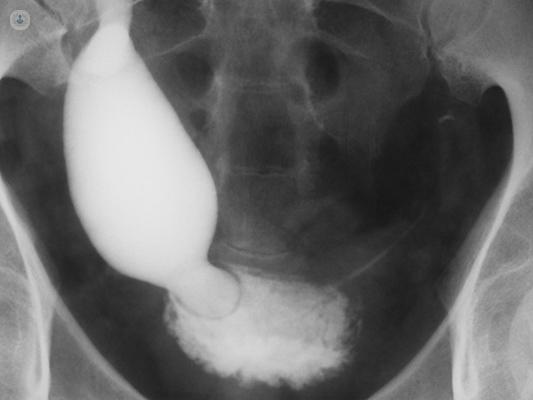Ureterocele
Mr Sanjiv Kumar Agarwal - Urology
Created on: 02-21-2018
Updated on: 04-27-2023
Edited by: Conor Dunworth
What is a ureterocele?
A ureterocele is a congenital condition affecting the ureters (the tubes that carry urine from the kidneys to the bladder). The end of the ureter that enters the bladder doesn’t develop properly, and as a result, the flow of urine becomes blocked. The ureter swells like a balloon where it enters the bladder, and the blockage of urine can lead to further problems.
Prognosis of the illness/condition
Ureteroceles can occur in one or both ureters. The swelling may be limited to where the ureter enters the bladder, or if the blockage is severe, the rest of the tube may also become enlarged as urine becomes backed up. It can also be associated with vesicoureteral reflux, in which urine splashes back up the ureter to the kidney. This can spread urine infections and lead to kidney damage.
Symptoms of a ureterocele
Ureteroceles may not display any symptoms. Others may be large enough that a lump can be felt or even seen in the case of girls. Urinary symptoms may develop either as a direct result of the ureterocele or as a result of a urinary tract infection (UTI) caused by the condition:
- Pain and/or burning sensation while urinating
- Foul-smelling urine
- Frequent urination
- Urinary incontinence
- Feeling like the bladder has not fully emptied
- Blood in the urine
Patients may also experience fever and abdominal pain.
Medical tests to diagnose a ureterocele
In most cases, ureteroceles are diagnosed in babies and toddlers below the age of two. They are usually spotted on early ultrasound scans. They sometimes go unnoticed until the child is older, or occasionally until they are an adult. Besides ultrasound, doctors may use the following to diagnose a ureterocele:
- Voiding cystourethrogram (VCUG) – a test that assesses bladder function.
- Arenal scan – evaluates kidney function.
- CT scans
- MRI scans
- Urine test – this tests for signs of a urinary tract infection.
What are the causes of ureterocele?
Ureteroceles are congenital (the patient is born with the condition). The end of the ureter doesn’t develop properly in the womb.
Treatments for ureterocele
Treatment for a ureterocele depends largely on when it is diagnosed and what (if any) symptoms it is causing. If the patient is otherwise healthy, the doctor may recommend simply monitoring the condition. In other cases, surgical intervention may be necessary.
In infants, a minor procedure called a ureterocele puncture may be performed. This involves inserting a small camera through the urethra to the bladder and puncturing the ureterocele so that urine can flow as normal.
In older children and adults, more drastic surgery may be necessary to reconstruct that part of the urinary tract.
Which type of specialist treats ureteroceles?
Paediatric urologists typically treat ureteroceles, as it is most commonly treated in infancy and childhood.



